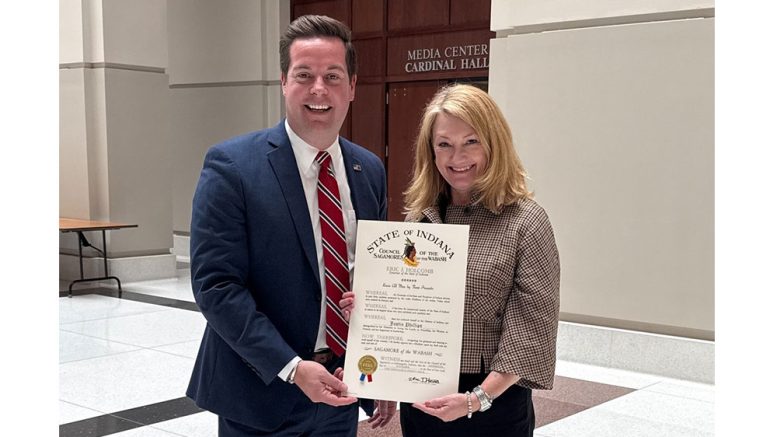By STU CLAMPITT
news@readthereporter.com
Overdose Lifeline recently distributed its one millionth naloxone kit. Meanwhile, Indiana has seen a 19 percent decrease in overdose deaths – a larger decline than the 14.9 percent nationally.
This month, Overdose Lifeline Founder Justin Phillips was awarded Indiana’s highest honor, the Sagamore of the Wabash. The Reporter spoke to Phillips about the work that led to her award and the work that led to it.
“We are basing this [one million doses] on the numbers starting in 2020 when we formed this partnership with the state of Indiana,” Phillips told The Reporter. “If we counted the smaller quantities that we distribute before 2020, we’d be over a million. But when the pandemic came and the state approached us about setting up this distribution model, that is when we’re counting from to get to the one million.”
Phillips said they could never have reached this milestone without the network of volunteers. Approximately 50 people show up every other Tuesday night to make kits at the Overdose Lifeline office. They also have partnerships with Marion University, IU School of Nursing, National Bank of Indianapolis, and Center Bank, all of whom have encouraged their employees to help get to the one million naloxone kits mark.
“We could absolutely not do it without those volunteers,” Phillips said. “We used to make kits ourselves, but because now we’ve built this army of volunteers, we don’t have to do that as frequently anymore, which is a tremendous lift of burden.”
Now Overdose Lifeline is free to focus on processing and fulfilling requests, as well as and tracking the data from their now huge network.
“We have a request form on our website,” Phillips said. “It’s at the very top of the webpage that all someone has to do is fill out a simple form that can or cannot be anonymous. And we will mail naloxone to them at their address. It’s also possible for you to visit a NaloxBox, which is something that can be found in public spaces. It’s also possible to visit a local distributor. There is a map on our website, in addition to the request form.”
With the holiday season upon us, the potential for people suffering or recovering from addiction to turn to opioids is higher. Naloxone (a.k.a. Narcan) distribution can be a controversial topic, so The Reporter asked Phillips to address that stigma for our readers.
“Substance use disorder addiction is a chronic disease,” Phillips said. “The organ effected is the brain, in much the same way we have organs affected by other chronic diseases like pancreas or the heart. We would never deny someone health care because they have a setback in their disease. A Type 2 diabetic is not going to be denied life-saving insulin because they struggled with following their diet one day. And this is no different. Unfortunately, it’s very stigmatized.”
Phillips also spoke about the perception that naloxone is often seen as a kind of “safety net” for drug users.
“The truth of the matter is access to naloxone does nothing but keep someone alive long enough to get them to recovery,” Phillips said. “No one finds recovery if they’re dead and no one uses with the idea that there is a safety net for them because they’re not using it. It’s just not how addiction works. Addiction is very complicated hijacking of the brain. There’s just not really a lot of logic, unfortunately, for people with addiction.”
Overdose Lifeline has vending machines available, each of which holds 350 doses of naloxone. They also have community partners available to distribute doses across Indiana. In all cases, it is free to those who need it.
A map of locations is available online at overdoselifeline.org/naloxone-indiana-distribution.
“There’s no need to worry about shame or stigma,” Phillips said. “There’s plenty of opportunity to access it without having to interact with the human. And we have other harm reduction resources for individuals who are interested as well.”
Justin Phillips founded Overdose Lifeline after the death of her youngest son, Aaron, from a heroin overdose at the age of 20. Phillips started the organization as a way to help those with substance addictions and the people who love them.
For more information about Overdose Lifeline, visit OverdoseLifeline.org. You can also request naloxone and fentanyl test strips on that website.
If you would like to help Overdose Lifeline continue its work, you can donate online at overdoselifeline.org/donate.

